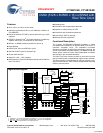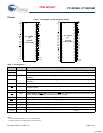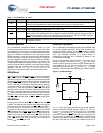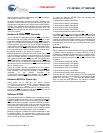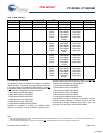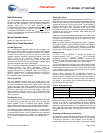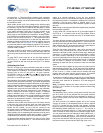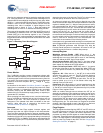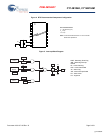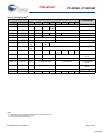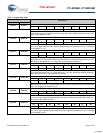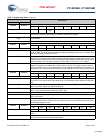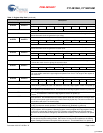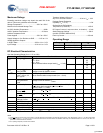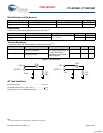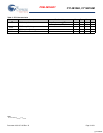
PRELIMINARY
CY14B104K, CY14B104M
Document #: 001-07103 Rev. *K Page 7 of 31
must be set to ‘1’. This turns off the oscillator circuit, extending
the battery life. If the OSCEN bit goes from disabled to enabled,
it takes approximately one second (two seconds maximum) for
the oscillator to start.
While system power is off, If the voltage on the backup supply
(V
RTCcap
or V
RTCbat
) falls below their respective minimum level,
the oscillator may fail.The CY14B104K has the ability to detect
oscillator failure when system power is restored. This is recorded
in the OSCF (Oscillator Failed bit) of the flags register at the
address 0x7FFF0. When the device is powered on (V
CC
goes
above V
SWITCH
) the OSCEN bit is checked for “enabled” status.
If the OSCEN bit is enabled and the oscillator is not active within
the first 5 ms, the OSCF bit is set to “1”. The system must check
for this condition and then write ‘0’ to clear the flag. Note that in
addition to setting the OSCF flag bit, the time registers are reset
to the “Base Time” (see Setting the Clock on page 6), which is
the value last written to the timekeeping registers. The control or
calibration registers and the OSCEN bit are not affected by the
‘oscillator failed’ condition.
The value of OSCF must be reset to ‘0’ when the time registers
are written for the first time. This initializes the state of this bit
which may have become set when the system was first powered
on.
To reset OSCF, set the write bit “W” (in the Flags register at
0x7FFF0) to a “1” to enable writes to the Flag register. Write a
“0” to the OSCF bit and then reset the write bit to “0” to disable
writes.
Calibrating the Clock
The RTC is driven by a quartz controlled crystal with a nominal
frequency of 32.768 kHz. Clock accuracy depends on the quality
of the crystal and calibration. The crystals available in market
typically have an error of +
20 ppm to +35 ppm. However,
CY14B104K employs a calibration circuit that improves the
accuracy to +1/–2 ppm at 25°C. This implies an error of +2.5
seconds to -5 seconds per month.
The
calibration circuit adds or subtracts counts from the oscillator
divider circuit to achieve this accuracy. The number of pulses that
are suppressed (subtracted, negative calibration) or split (added,
positive calibration) depends upon the value loaded into the five
calibration bits found in Calibration register at 0x7FFF8. The
calibration bits occupy the five lower order bits in the Calibration
register. These bits are set to represent any value between ‘0’
and 31 in binary form. Bit D5 is a sign bit, where a ‘1’ indicates
positive calibration and a ‘0’ indicates negative calibration.
Adding counts speeds the clock up and subtracting counts slows
the clock down. If a binary ‘1’ is loaded into the register, it corre-
sponds to an adjustment of 4.068 or –2.034 ppm offset in oscil-
lator error, depending on the sign.
Calibration occurs within a 64-minute cycle. The first 62 minutes
in the cycle may, once per minute, have one second shortened
by 128 or lengthened by 256 oscillator cycles. If a binary ‘1’ is
loaded into the register, only the first two minutes of the
64-minute cycle are modified. If a binary 6 is loaded, the first 12
are affected, and so on. Therefore, each calibration step has the
effect of adding 512 or subtracting 256 oscillator cycles for every
125,829,120 actual oscillator cycles, that is, 4.068 or –2.034 ppm
of adjustment per calibration step in the Calibration register.
To determine the required calibration, the CAL bit in the Flags
register (0x7FFF0) must be set to ‘1’. This causes the INT pin to
toggle at a nominal frequency of 512 Hz. Any deviation
measured from the 512 Hz indicates the degree and direction of
the required correction. For example, a reading of 512.01024 Hz
indicates a +20 ppm error. Hence, a decimal value of –10
(001010b) must be loaded into the Calibration register to offset
this error.
Note Setting or changing the Calibration register does not affect
the test output frequency.
To set or clear CAL, set the write bit “W” (in the flags register at
0x7FFF0) to “1” to enable writes to the Flag register. Write a
value to CAL, and then reset the write bit to “0” to disable writes.
Alarm
The alarm function compares user programmed values of alarm
time and date (stored in the registers 0x7FFF1-5) with the corre-
sponding time of day and date values. When a match occurs, the
alarm internal flag (AF) is set and an interrupt is generated on
INT pin if Alarm Interrupt Enable (AIE) bit is set.
There are four alarm match fields - date, hours, minutes, and
seconds. Each of these fields has a match bit that is used to
determine if the field is used in the alarm match logic. Setting the
match bit to ‘0’ indicates that the corresponding field is used in
the match process. Depending on the match bits, the alarm
occurs as specifically as once a month or as frequently as once
every minute. Selecting none of the match bits (all 1s) indicates
that no match is required and therefore, alarm is disabled.
Selecting all match bits (all 0s) causes an exact time and date
match.
There are two ways to detect an alarm event: by reading the AF
flag or monitoring the INT pin. The AF flag in the flags register at
0x7FFF0 indicates that a date or time match has occurred. The
AF bit is set to “1” when a match occurs. Reading the flags
register clears the alarm flag bit (and all others). A hardware
interrupt pin may also be used to detect an alarm event.
To set, clear or enable an alarm, set the ‘W’ bit (in Flags Register
- 0x7FFF0) to ‘1’ to enable writes to Alarm Registers. After writing
the alarm value, clear the ‘W’ bit back to “0” for the changes to
take effect.
Note CY14B104K requires the alarm match bit for seconds
(0x7FFF2 - D7) to be set to ‘0’ for proper operation of Alarm Flag
and Interrupt.
Watchdog Timer
The Watchdog Timer is a free running down counter that uses
the 32 Hz clock (31.25 ms) derived from the crystal oscillator.
The oscillator must be running for the watchdog to function. It
begins counting down from the value loaded in the Watchdog
Timer register.
The timer consists of a loadable register and a free running
counter. On power up, the watchdog time out value in register
0x7FFF7 is loaded into the Counter Load register. Counting
begins on power up and restarts from the loadable value any time
the Watchdog Strobe (WDS) bit is set to ‘1’. The counter is
compared to the terminal value of ‘0’. If the counter reaches this
value, it causes an internal flag and an optional interrupt output.
You can prevent the time out interrupt by setting WDS bit to ‘1’
prior to the counter reaching ‘0’. This causes the counter to
reload with the watchdog time out value and to be restarted. As
long as the user sets the WDS bit prior to the counter reaching
the terminal value, the interrupt and WDT flag never occur.
[+] Feedback



